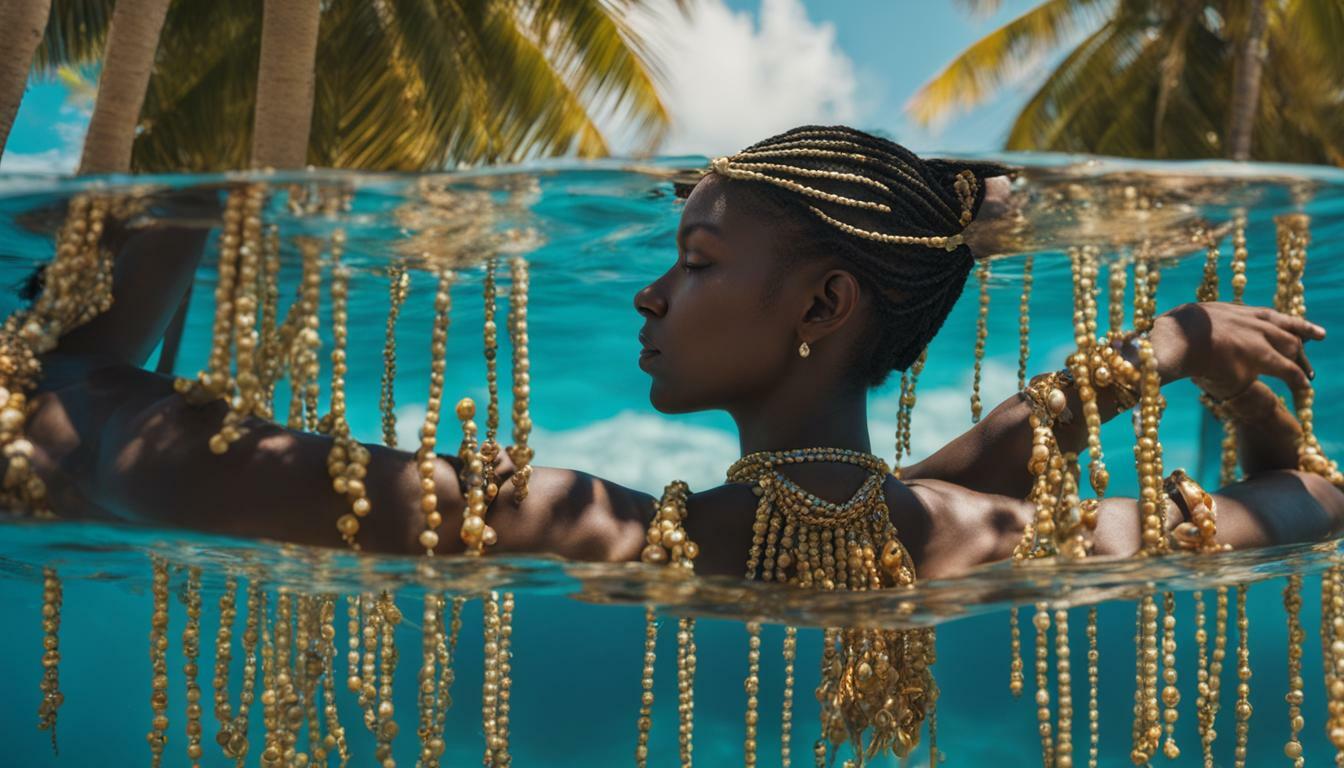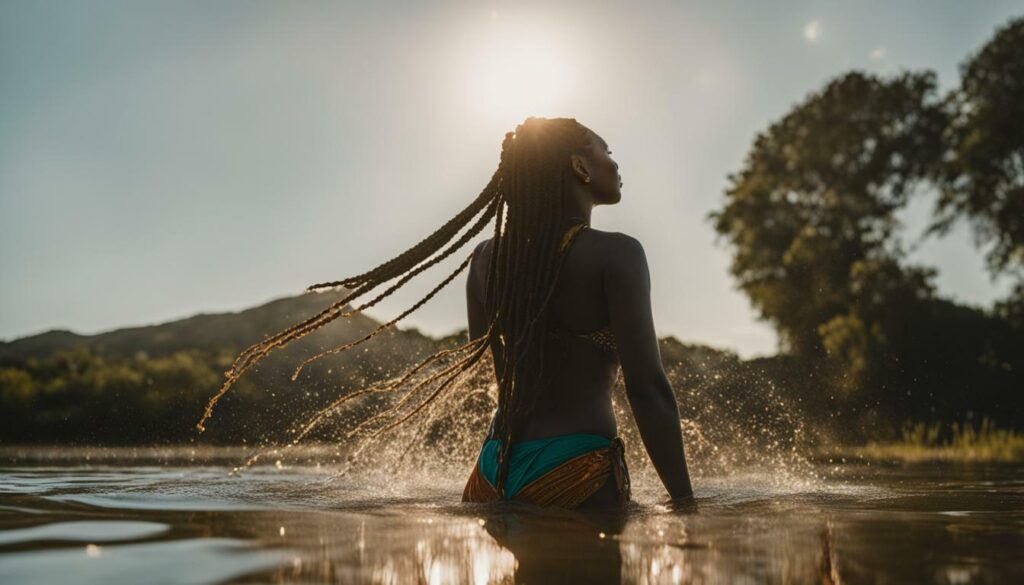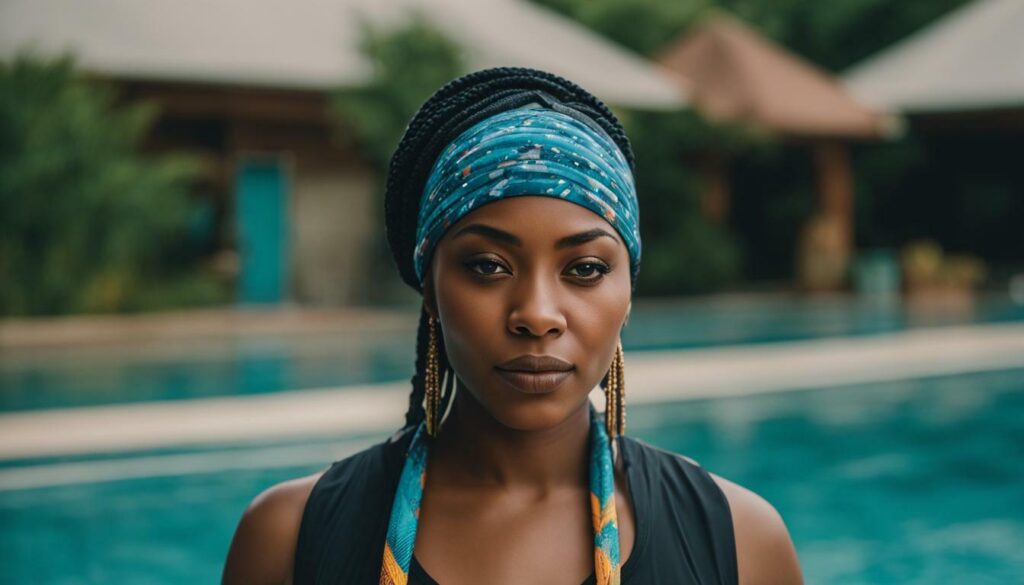
If you’re wondering whether it’s possible to take a plunge with your stunning Fulani braids, the answer is yes! When installed correctly, Fulani braids encase your natural hair securely, reducing the risk of slippage or unraveling even when they come in contact with water. However, it’s important to take proper care of your braids while swimming to ensure they stay in good condition.
- Swimming with Fulani braids is possible if they are installed correctly.
- Take precautions to protect your braids, such as rinsing your hair after swimming to remove chlorine.
- Scrub and moisturize your scalp to prevent irritation.
- Ensure your braids are completely dry to avoid mold and mildew growth.
- Choose a braided style that can withstand water activities.
How to Protect Your Braids While Swimming
To ensure your Fulani braids stay in excellent condition while enjoying a refreshing swim, here are some essential steps to protect your braids:
- Rinse Your Hair After Swimming: After swimming, it’s important to rinse your hair to wash away chlorine and any other chemicals that may have been present in the water. Chlorine can be drying and damaging to your hair, so it’s crucial to remove it as soon as possible. Use clean water to thoroughly rinse your braids, ensuring that all traces of chlorine are washed away.
- Scrub and Moisturize Your Scalp: While swimming, your scalp may come into contact with chlorine or other irritants. To prevent any discomfort or irritation, it’s recommended to scrub your scalp gently with a sulfate-free shampoo or a clarifying shampoo specifically designed for braids. Follow up with a moisturizing conditioner to keep your scalp hydrated and nourished.
- Ensure Your Braids Are Completely Dry: Excess water can lead to mold and mildew growth, which can cause damage to your braids. After swimming, make sure your braids are thoroughly dried. You can use a clean, dry towel to gently squeeze out any excess water from your hair. If possible, allow your hair to air dry naturally in a well-ventilated area.
Additionally, it’s important to choose the right braided style that can handle water activities. Some braided styles are more suitable for swimming and water-related activities, as they are less likely to come undone or get damaged. Speak to your hairstylist or do some research to find braided styles that are known for their durability in water.

Another helpful tip is to wet your braids with clean water before swimming. By wetting your braids beforehand, you can minimize the amount of chlorine absorbed by your hair. This can help to preserve the integrity of your braids and reduce any potential damage from chlorine exposure.
If you prefer extra protection, consider wearing a swim cap specifically designed for braided hairstyles. A swim cap can help keep your braids dry and prevent water from penetrating and causing damage. Choose a swim cap that fits securely and comfortably over your braids.
By following these steps and taking the necessary precautions, you can enjoy swimming with your Fulani braids while keeping them in great condition.
| Protect Your Braids While Swimming | Summary |
|---|---|
| Rinse Your Hair After Swimming | Wash away chlorine and chemical residues. |
| Scrub and Moisturize Your Scalp | Prevent irritation and keep your scalp hydrated. |
| Ensure Your Braids Are Completely Dry | Avoid mold and mildew growth. |
| Choose the Right Braided Style | Opt for styles that can handle water activities. |
| Wet Your Braids Beforehand | Minimize chlorine absorption. |
| Consider a Swim Cap | Extra protection to keep your braids dry. |
Choosing the right braided style for swimming
Not all braided styles are created equal when it comes to swimming; here are some options to consider for a hassle-free water experience with your Fulani braids. One popular choice is the classic cornrow style. Cornrows are tightly braided close to the scalp, providing excellent protection and minimizing frizz. Another great option is the box braid style. Box braids are thick and durable, making them perfect for swimming as they can withstand the effects of water without easily unraveling.
If you prefer a more intricate look, Senegalese twists are a fantastic choice. These twists are lightweight and versatile, allowing you to create different styles while maintaining the integrity of your braids. Another option is the Goddess braid style. These braids are larger in size and can be easily styled into different updos, making them a convenient choice for swimming and water activities.
Remember, when choosing a braided style for swimming, it’s important to consider the thickness, tightness, and versatility of the braids. Styles that are too thin or loosely braided may not hold up well in water and are more prone to frizz and unraveling. Opting for styles that encase your natural hair tightly will provide better protection and longevity for your braids.
| Braided Style | Features |
|---|---|
| Cornrows | Tightly braided close to the scalp, minimal frizz |
| Box Braids | Thick and durable, resistant to unraveling |
| Senegalese Twists | Lightweight, versatile styling options |
| Goddess Braids | Larger size, convenient updo options |

Not all braided styles are suitable for swimming, so it’s important to choose a style that can withstand the effects of water without compromising the integrity of your braids. By opting for cornrows, box braids, Senegalese twists, or goddess braids, you can confidently enjoy swimming and water activities without worrying about your braids frizzing or unraveling.
Wet your braids before swimming
One simple step that can make a big difference in protecting your Fulani braids while swimming is to wet them with clean water beforehand. Here’s why and how.
When your braids are wet, they become less porous, which means they absorb less chlorine from the pool water. By wetting your braids before swimming, you create a barrier that minimizes the amount of chlorine that can penetrate and potentially damage your braids. This is especially important if you plan to spend a significant amount of time in the water.
To wet your braids, fill a spray bottle with clean water and mist your braids thoroughly. Make sure to saturate every section, from roots to ends, ensuring that the water reaches every braid and the underlying natural hair. You can also use your hands to dampen your braids if a spray bottle is not available.

| Benefits of wetting your braids before swimming: |
|---|
| Minimizes chlorine absorption |
| Protects braids from drying out |
| Reduces frizz and unraveled braids |
| Preserves the longevity of your braids |
Summary:
Wetting your braids with clean water before swimming is a simple yet effective way to protect them from chlorine damage. By doing so, you create a barrier that minimizes chlorine absorption and helps maintain the integrity of your braids. Remember to thoroughly saturate your braids with water, ensuring every braid and the underlying natural hair is damp. This one extra step can make a significant difference in preserving the longevity of your Fulani braids while enjoying your time in the water.
Considering a Swim Cap
If you’re looking for an extra layer of protection and peace of mind while swimming with your beautiful Fulani braids, consider using a swim cap – here’s what you need to know. A swim cap can help keep your braids dry and shielded from the damaging effects of water. It provides a barrier between your braids and the pool or ocean water, preventing frizz, tangling, and the absorption of chlorine or salt.
When choosing a swim cap for your braided hairstyle, opt for a cap made of silicone or latex material. These materials are waterproof and durable, ensuring that your braids stay protected throughout your swim. Look for a swim cap that is large enough to accommodate your braids without causing discomfort or pulling on them. A cap with a snug fit will reduce the chances of water seeping in and affecting your braids.
Before putting on the swim cap, make sure your braids are dry or lightly damp. Wetting your braids before wearing a swim cap can increase the risk of mold and mildew growth. Gently gather your braids together and tuck them under the cap, ensuring that all of your braids are securely tucked in. Adjust the cap to fit tightly around your hairline, creating a seal that will prevent water from entering.

| Benefits of Using a Swim Cap |
|---|
| Protection: A swim cap provides a protective barrier that shields your braids from water damage, chlorine, and salt. |
| Reduced Frizz: By keeping your braids dry, a swim cap helps to minimize frizz and keep your hairstyle intact while swimming. |
| Hygiene: Wearing a swim cap not only protects your braids but also helps maintain cleanliness by reducing exposure to potentially dirty pool water. |
| Comfort: A properly fitted swim cap ensures a comfortable swimming experience, free from the distraction of water-soaked braids. |
| Durability: Investing in a high-quality swim cap will provide long-lasting protection for your braids, making it a worthwhile accessory for any water activities. |
Conclusion
Swimming with Fulani braids is absolutely possible, and by following some simple guidelines and taking the necessary precautions, you can enjoy the water while keeping your braids intact and beautiful.
When installed correctly, Fulani braids encase your natural hair and won’t slip out, making them a great choice for water activities. They are less likely to get frizzy or unravel when they come in contact with water. However, it’s important to protect your braids to maintain their quality.
Rinsing your hair after swimming is crucial to wash away chlorine and other chemicals that can damage your braids. It’s also important to scrub and moisturize your scalp to prevent irritation and ensure your braids are thoroughly dried to prevent mold and mildew growth. Choosing the right braided style that can handle water is also recommended.
Additionally, wetting your braids with clean water before swimming can help minimize chlorine absorption, further protecting your braids. If you want extra protection, consider wearing a swim cap specifically designed for braided hairstyles. A swim cap can help keep your braids dry and prevent water damage.
By following these guidelines and taking proper care of your braids, you can confidently swim with Fulani braids without worrying about them getting ruined. So go ahead, dive in and make a splash while rocking your beautiful braids!
FAQ
Can you swim with Fulani braids?
Yes, you can swim with Fulani braids. When installed correctly, Fulani braids encase your natural hair and won’t slip out. They are less likely to get frizzy or unravel when they come in contact with water.
How to protect your braids while swimming
To protect your braids while swimming, rinse your hair after swimming to wash away chlorine, scrub and moisturize your scalp to prevent irritation, and ensure your braids are thoroughly dried to prevent mold and mildew growth.
Choosing the right braided style for swimming
When swimming, it’s important to choose a braided style that can handle water. Opt for braided styles that are more suitable for swimming and water-related activities, ensuring your braids remain intact even in the water.
Wetting your braids before swimming
Wetting your braids with clean water before swimming can minimize the absorption of chlorine. It’s recommended to wet your braids before getting into the water to reduce the amount of chlorine your braids come in contact with.
Considering a swim cap
Using a swim cap can help protect your Fulani braids while swimming. A swim cap keeps your braids dry and prevents water damage. Choose a swim cap that accommodates your braided hairstyle for optimal protection.






